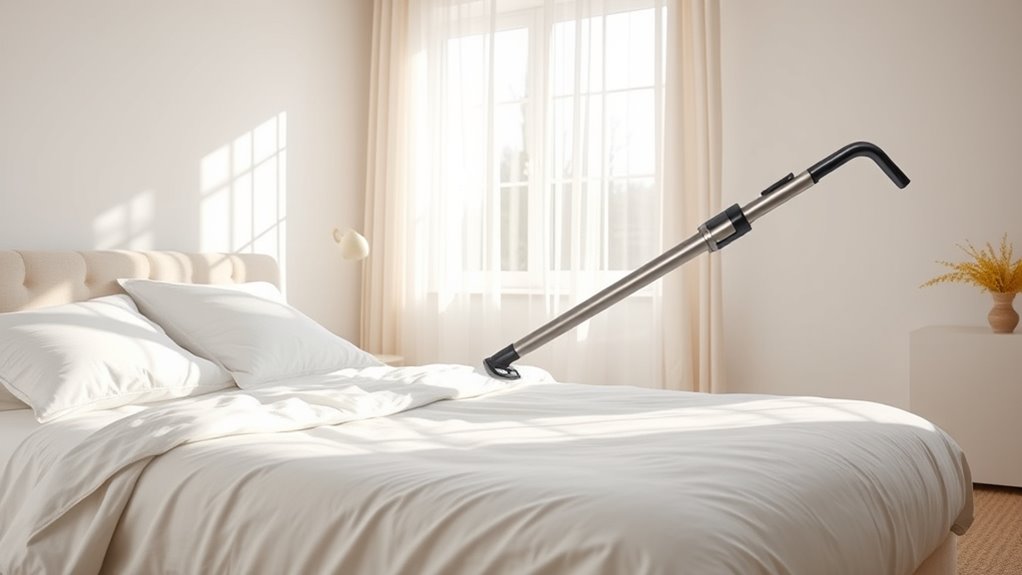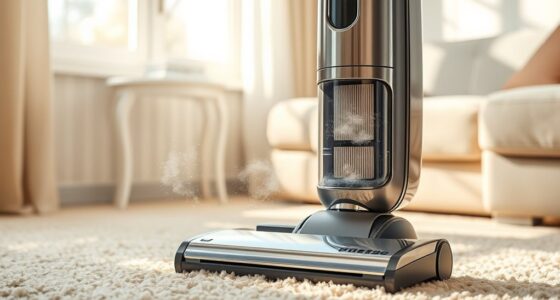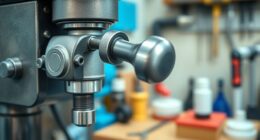To allergy-proof your bedroom quickly, start with your mattress and pillows by washing bedding in hot water and using allergen-proof covers. Vacuum carpets, rugs, and upholstered furniture thoroughly with a HEPA-filter vacuum, paying special attention to seams and hidden areas. Wipe down surfaces and clean air vents to remove dust, then mop or damp wipe all surfaces. Maintaining this routine and scheduling regular vacuuming will keep allergens at bay—continue and discover even more effective tips.
Key Takeaways
- Vacuum mattress, pillows, and bedding weekly with a HEPA-filter vacuum to remove dust mites and allergens.
- Focus vacuuming on carpets, rugs, and under furniture to eliminate hidden dust buildup.
- Use vacuum attachments to clean upholstery, curtains, and seams of mattresses and furniture.
- Wipe down surfaces and air vents with a damp microfiber cloth to reduce settled dust.
- Ensure thorough vacuuming of high-traffic areas and under furniture for maximum allergen removal.
Prioritize Your Mattress and Pillows

Your mattress and pillows are the biggest sources of dust mites and allergens in your bedroom, so prioritizing them is essential. Switch to hypoallergenic bedding and allergy-resistant fabrics to minimize allergen buildup. These specially designed materials prevent dust mites from settling and reduce allergen exposure. Wash your bedding weekly in hot water to eliminate mites and allergens effectively. Consider using allergen-proof mattress and pillow covers for an added barrier. Regularly vacuum and clean your mattress to remove dust and skin flakes. Using UV filters in your vacuum cleaner can help kill remaining dust mites and allergens more effectively. By investing in hypoallergenic bedding and choosing fabrics that resist allergens, you create a cleaner, healthier sleep environment. This simple switch can markedly reduce allergy symptoms and improve your overall sleep quality.
Focus on Carpets and Rugs
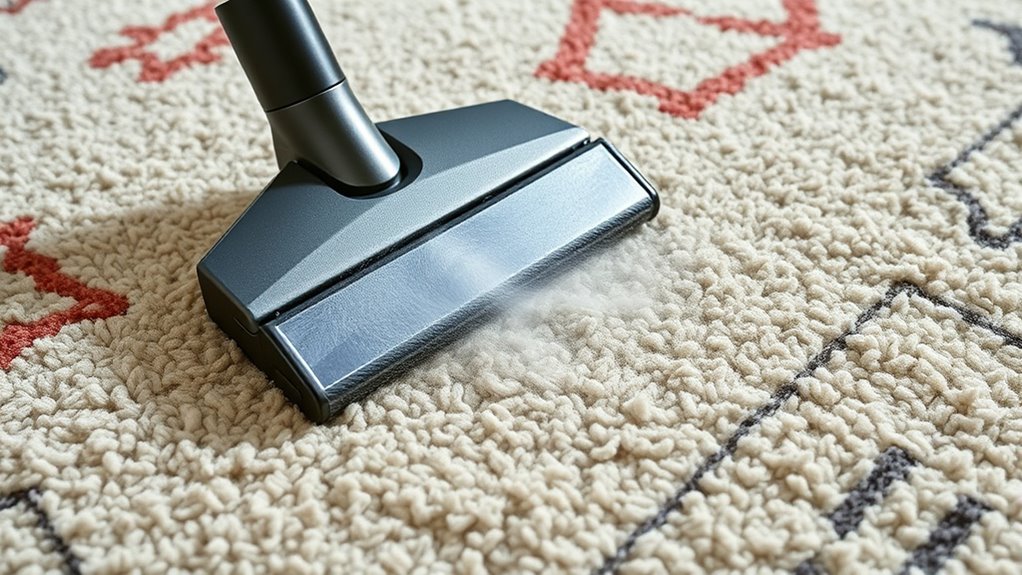
Carpets and rugs can harbor a significant amount of dust, pet dander, and allergens that worsen allergy symptoms. Dust mites settle deep into fibers, making it easy for allergy triggers to accumulate. To reduce these triggers, vacuum carpets and rugs thoroughly using a high-efficiency particulate air (HEPA) filter vacuum. Focus on areas with heavy foot traffic and under furniture where dust mites tend to thrive. Regular vacuuming removes surface allergens and prevents buildup, improving air quality. Consider vacuuming at least twice a week and more often if you have pets. If possible, choose washable rugs or remove carpets altogether, as they’re harder to keep allergen-free. Keeping your carpets clean is a quick and effective step to minimize allergy symptoms. Using a vacuum with HEPA filters helps capture microscopic allergens more effectively.
Tackle Upholstered Furniture and Curtains
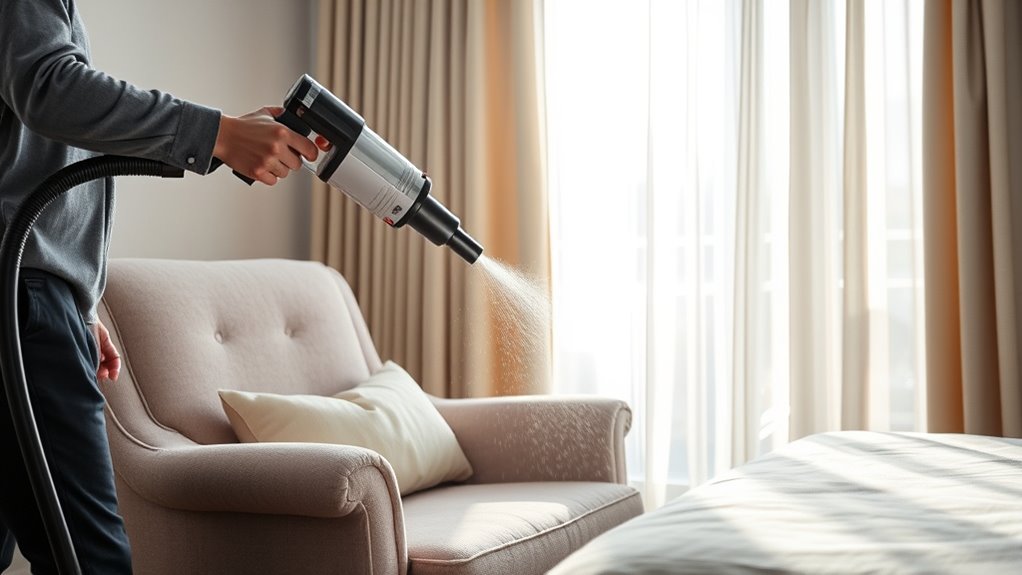
Since regular vacuuming helps keep carpets and rugs free of allergens, it’s equally important to address upholstered furniture and curtains where dust and pet dander can settle. To effectively reduce allergens, focus on these key tasks:
- Use a vacuum with a HEPA filter to thoroughly clean upholstered furniture, removing trapped dust and dander.
- Regularly perform curtain cleaning by vacuuming curtains or washing them if possible.
- Pay special attention to seams and crevices where dust tends to accumulate.
- Incorporating air purification into your cleaning routine can further help remove airborne allergens and improve indoor air quality.
Clean Your Bedroom Surfaces and Air Vents

To effectively reduce allergens in your bedroom, it’s essential to regularly clean surfaces and air vents where dust and pet dander can settle. Dust mites thrive on these surfaces, releasing allergens that trigger reactions. Use a damp cloth or microfiber duster to wipe down shelves, nightstands, and other flat surfaces, removing accumulated dust and allergen buildup. Don’t forget to clean air vents and registers, as they can circulate dust and dander throughout the room. Wipe vent covers with a damp cloth or vacuum them with a brush attachment to ensure thorough allergen removal. Keeping these areas clean minimizes dust mite habitats and reduces airborne allergens, making your bedroom a healthier, more comfortable space for allergy relief. Additionally, employing advanced AI-enhanced cleaning tools can help identify and target hidden dust hotspots more effectively.
Maintain a Regular Vacuuming Schedule
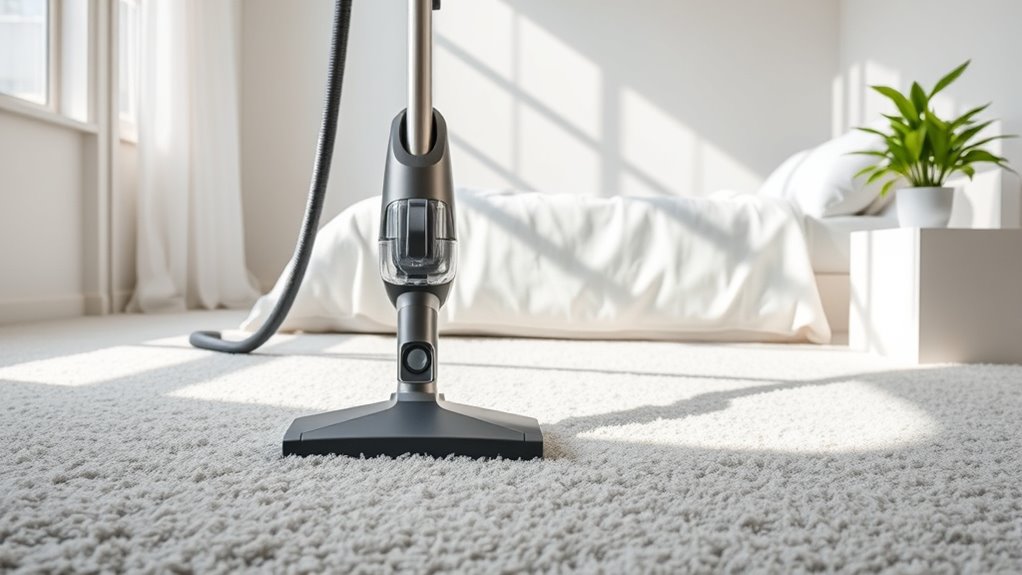
Establishing a regular vacuuming schedule is one of the most effective ways to keep allergens at bay in your bedroom. Consistent vacuuming helps with dust mite prevention and enhances allergen reduction strategies. To maximize effectiveness:
- Vacuum carpets and rugs at least twice a week with a HEPA-filter vacuum
- Use a handheld or edge attachment to clean mattress seams and upholstered furniture
- Don’t forget to vacuum under furniture and along baseboards regularly
- Incorporate tuning modifications to your vacuum cleaner, such as HEPA filters and sealed systems, for even better allergen containment
Frequently Asked Questions
What Type of Vacuum Cleaner Is Best for Allergy-Proofing?
For allergy-proofing, you should choose a vacuum cleaner with HEPA filters, as they trap tiny allergens like dust mites and pet dander. A model designed for carpet cleaning is especially effective because it removes embedded debris that can trigger allergies. Make sure your vacuum has strong suction and a sealed system to prevent allergens from escaping. Regular use with these features keeps your bedroom environment healthier and allergen-free.
Can Vacuuming Remove All Allergens From My Bedroom?
Think of vacuuming as a mighty broom sweeping away surface allergens, but it’s not a magic wand. You won’t remove all allergens, especially those lurking deep in carpets or bedding. Pair your vacuuming with air purifier benefits to clear airborne irritants. If allergies persist, allergy medication can help. Combining these efforts creates a fortress against allergens, making your bedroom a safer haven for breathing easy.
How Often Should I Replace My Vacuum Filters?
You should replace your vacuum filters every three to six months to maintain ideal vacuum maintenance and filter longevity. Regularly changing filters prevents buildup of dust and allergens, ensuring your vacuum works efficiently. If you have pets or allergies, consider replacing filters more frequently. Proper filter replacement keeps your vacuum running smoothly and helps keep your environment healthier, especially when focusing on allergy-proofing your bedroom.
Are There Specific Vacuum Attachments for Delicate Surfaces?
You won’t believe how much easier cleaning becomes with the right vacuum attachment! For delicate surfaces, you definitely need a specialized vacuum attachment that gently lifts dust without causing damage. These attachments are designed specifically for delicate surfaces like upholstery, drapes, or fragile furniture. Using the correct vacuum attachment for delicate surfaces guarantees you clean thoroughly without risking scratches or tears, making your cleaning routine more efficient and safe.
Can Vacuuming Alone Eliminate All Bedroom Dust Mites?
Vacuuming alone can markedly reduce dust mites, but it may not eliminate all of them because of the dust mite lifecycle. Mites hide deep within carpets and bedding, so combining vacuuming with proper carpet cleaning techniques ensures better results. Regularly washing bedding, using high-temperature settings, and vacuuming thoroughly help break the lifecycle, making your bedroom less hospitable for dust mites and improving your allergy symptoms.
Conclusion
Did you know that regular vacuuming can reduce indoor allergens by up to 60%? By focusing on your mattress, carpets, furniture, and surfaces, you create a healthier sleeping environment. Just 20 minutes is enough to make a big difference in allergy-proofing your bedroom. Keep up with your routine, and you’ll breathe easier, night after night. Start today, and enjoy the benefits of a cleaner, allergen-free space!

